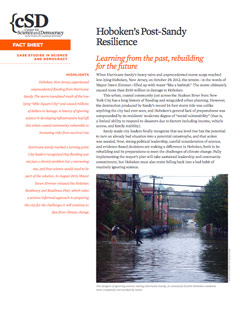When Superstorm Sandy’s heavy rains and unprecedented storm surge swept across low-lying Hoboken, New Jersey, on October 29, 2012, the streets—in the words of Hoboken’s Mayor Dawn Zimmer—filled up with water “like a bathtub." The storm caused more than $100 million in damage.
As an urban coastal community just across the Hudson River from New York City, Hoboken had a long history of flooding and of misguided property development.
However, the destruction produced by Sandy's record 14-foot storm tide was unlike anything the city had seen before, and the impact was exacerbated by the social vulnerabilities of Hoboken's population.
In the aftermath, city leaders finally recognized that action was needed. Strong political leadership, careful consideration of the science, and evidence-based decisions are making a difference in Hoboken's post-Sandy rebuilding. However, sustained leadership and community commitment will be needed to overcome the city's long history of sidelining science.




